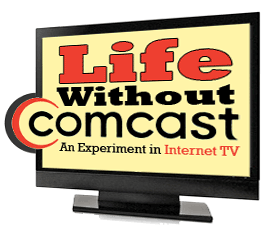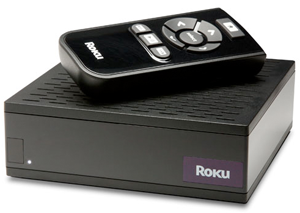 I’ve been remiss in not updating you on my experiment in using an Apple TV with Boxee’s media-center software as a substitute for my pricey Comcast service. “Life Without Comcast” may be a misleading title, since I haven’t tried to go cold turkey–instead, I’ve done some of my TV watching via cable, and some via the Internet, and have been comparing the two experiences as I did so.
I’ve been remiss in not updating you on my experiment in using an Apple TV with Boxee’s media-center software as a substitute for my pricey Comcast service. “Life Without Comcast” may be a misleading title, since I haven’t tried to go cold turkey–instead, I’ve done some of my TV watching via cable, and some via the Internet, and have been comparing the two experiences as I did so.
So far, my main conclusion is that these two ways to consume video content are just…different. To wit:
Pro-Comcast Points:
Cable isn’t a victim of the Hulu-Boxee debacle. The single thing that played the biggest role in making my Apple TV/Boxee setup a plausible Comcast substitute was the fact that it let my watch Hulu, the Web’s leading source of broadcast TV programming. Last week, however, Hulu reluctantly asked Boxee to remove its Hulu support, and Boxee complied. End result: A lot of mainstay cable TV programming is no longer available on Boxee. True, it still has Joost, CBS, and other content providers, and Apple TV offers a wealth of for-pay movies and TV shows (as well as some stuff for free, in podcast form). But if I’d known that I wouldn’t be able to view Hulu on my TV, I would have been a lot less gung-ho about this whole experiment.
Cable is still a must for news junkies. Live streaming of broadcast news coverage over the Internet is rare, and often iffy when it does occur. Podcasts are available of some shows, but they’re always delayed, and often cut down. So I’m still doing much of my consuming of news via various all-news channels. And when major stories break, I still want the option of turning on the TV and surfing the coverage on multiple stations.
Cable is a heck of a lot closer to being glitch-free. Most means of watching video across the Internet are subject to at least occasional hiccups, and some are crippled by technical problems–especially when wireless networking is involved. Even Netflix’s slick and appealing Watch Instantly service has its issues: I tried to watch Network via it on my TiVo HD (see below) last night, and the soundtrack was out of sync with the image by about three seconds. With cable, I can be reasonably confident that the stuff I want to watch will work–and keep working until I’m done watching it.
HD is cool. And while I can get some HD content on Apple TV, it’s still a relative rarity. (Blocky YouTube-like video, on the other hand, is in plentiful supply.) When I want to watch high-def, Comcast has far more to offer.
Anti-Comcast points:
Financially, cable is woefully inefficient. At least for someone like me who doesn’t really gorge on TV. For every hour of cable programming I watch and enjoy, I’m paying for hundreds of stations of absolutely zero interest to me. (Sorry, Fox Soccer Channel, MTV Jams, ZeeTV, and Sprout.) The movies and TV shows that Apple delivers through Apple TV aren’t free, but they’re all a la carte.
Cable has a short attention span. Yesterday, I set up a TiVo HD, a few months after my beloved old standard-def TiVo more or less croaked on me. As part of get it up and running, I had to program it to record stuff I like–and I was startled by how many of the old sitcoms I dig are no longer available on cable. Dick Van Dyke, Mary Tyler Moore, and Bob Newhart are off the air…but they’re all on Hulu. And even if I can’t watch them on my Apple TV anymore, they’re available on my laptop.
Cable is available in one place. On the TV in my living room–unless I pay for extra set-top boxes. Or use a Slingbox (which, full disclosure, I do) to put it elsewhere. All the Internet TV I can get on Boxee is also available on all of my computers. Some of it’s on my iPhone, too, and over time I’m sure that all of it will be phone-friendly.
Cable is tied to a schedule. Yes, Comcast offers some shows and movies via its OnDemand video-on-demand service, and you can rent a Comcast DVR or buy something like a TiVo to watch your favorite stuff at any time. But you’re still going to miss some stuff you wanted to see because you forgot about it, or were busy when it was on. On the Web, by contrast, the default state of video programming is on demand: You can watch the last episode of Late Night With Conan O’Brien whenever you feel like it, and even if your DVR hasn’t been set to record Conan since the last millennium.
Bottom line: So far, at least, this little adventure hasn’t left me feeling like I can drop cable without missing it. At least not yet, and not via Boxee in its de-Hulued state. I’m continuing with the experiment, though, and will continue to write about it. You gotta think that Internet TV is going to evolve and improve rapidly over the next year or two, while cable is likely to stay pretty much like it is today.
Oh, and I am considering dropping the Comcast phone service I signed up for when I moved into my new home last summer–but that’s a subject for another post….
 At first, the kerfuffle involving the way startup Boxee used clever software to bring Hulu’s Internet TV service to TV sets was rather gentlemanly. Hulu asked Boxee to remove it, and explained why in a blog post that was almost apologetic–and which pretty much blamed it all on Hollywood content owners. Boxee thoughtfully replied in a post of its own–and complied. Unfortunate, yes, but civil.
At first, the kerfuffle involving the way startup Boxee used clever software to bring Hulu’s Internet TV service to TV sets was rather gentlemanly. Hulu asked Boxee to remove it, and explained why in a blog post that was almost apologetic–and which pretty much blamed it all on Hollywood content owners. Boxee thoughtfully replied in a post of its own–and complied. Unfortunate, yes, but civil.
 Roku’s little $100
Roku’s little $100  The iPhone is really an iManyThings: iCommunicator, iMusicPlayer, iGameConsole, and iRemoteControl. I’d love it to be an iTV, too–a rich source of on-demand television shows from broadcast and cable networks that stream live over its Net connection and (unlike the stuff Apple sells via iTunes) don’t cost anything. Little by little, that’s happening. Back in November,
The iPhone is really an iManyThings: iCommunicator, iMusicPlayer, iGameConsole, and iRemoteControl. I’d love it to be an iTV, too–a rich source of on-demand television shows from broadcast and cable networks that stream live over its Net connection and (unlike the stuff Apple sells via iTunes) don’t cost anything. Little by little, that’s happening. Back in November,  I’ve been remiss in not updating you on my
I’ve been remiss in not updating you on my  Many years ago–I think it was 1998 or thereabouts–I wrote a big feature story for PC World on a bevy of new devices that aimed to bring the Internet to America’s TV sets. I spent weeks living with Microsoft’s Web TV, Gateway 2000’s Destination living-room PC, and other gadgets. They were the first spawn of the technology industry’s irrational exuberance over the idea that the Web and TV were a match made in heaven. I didn’t fall in love with any of them. (I do, however, remember enjoying playing games on the Destination’s giant screen–as I recall, it was all of 32 inches.)
Many years ago–I think it was 1998 or thereabouts–I wrote a big feature story for PC World on a bevy of new devices that aimed to bring the Internet to America’s TV sets. I spent weeks living with Microsoft’s Web TV, Gateway 2000’s Destination living-room PC, and other gadgets. They were the first spawn of the technology industry’s irrational exuberance over the idea that the Web and TV were a match made in heaven. I didn’t fall in love with any of them. (I do, however, remember enjoying playing games on the Destination’s giant screen–as I recall, it was all of 32 inches.)